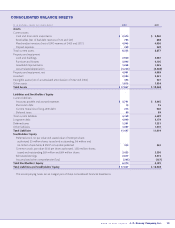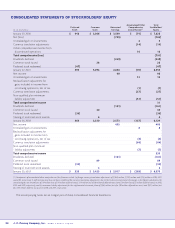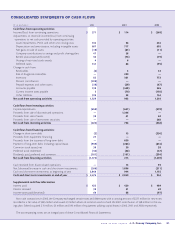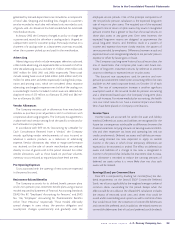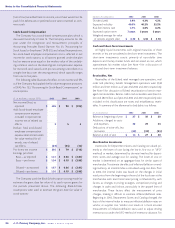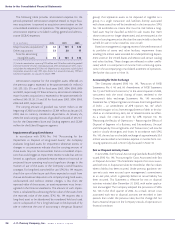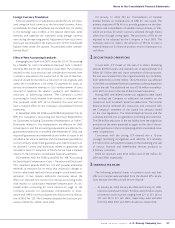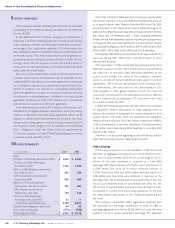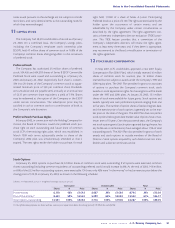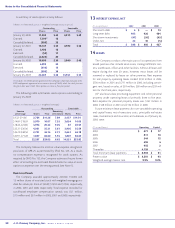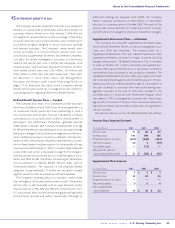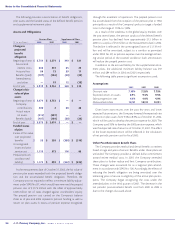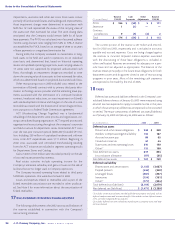JCPenney 2002 Annual Report Download - page 29
Download and view the complete annual report
Please find page 29 of the 2002 JCPenney annual report below. You can navigate through the pages in the report by either clicking on the pages listed below, or by using the keyword search tool below to find specific information within the annual report.
J. C. Penney Company, Inc. 2002 annual report26
Notes to the Consolidated Financial Statements
The following table provides amortization expense for the
periods presented. Amortization expense related to major busi-
ness acquisitions is reported as acquisition amortization on the
consolidated statements of operations. The remaining amount of
amortization expense is included in selling, general and adminis-
trative (SG&A) expenses.
($ in millions) 2002 2001 2000
Major business acquisitions(1) $42$ 121 $ 122
Other acquisitions 23 20 17
Total for amortizing
intangible assets $65$ 141 $ 139
(1) Includes amortization expense of $75 million and $76 million related to goodwill
and trade name for the years ending January 26, 2002 and January 27, 2001, respec-
tively, before the adoption of SFAS No. 142. Major business acquisitions include Eckerd
Corporation acquired in early 1997, Lojas Renner S.A. acquired in January 1999 and
Genovese Drug Stores, Inc. acquired in March 1999.
Amortization expense for the intangible assets reflected on
the previous page is expected to be approximately (in millions)
$65, $33, $25, $15 and $9 for fiscal years 2003, 2004, 2005, 2006
and 2007, respectively. Of these amounts, amortization related to
major business acquisitions is expected to be approximately (in
millions) $40, $9, $6, $1 and $0 for fiscal years 2003, 2004, 2005,
2006 and 2007, respectively.
The carrying amount of goodwill was $2,321 million at the
beginning of 2002 and decreased to $2,304 million at January 25,
2003, due to currency translation adjustments. At January 25,
2003, the total carrying amount of goodwill consisted of $35 mil-
lion for the Department Store and Catalog segment and $2,269
million for the Eckerd Drugstore segment.
Impairment of Long-Lived Assets
In accordance with SFAS No. 144, “Accounting for the
Impairment or Disposal of Long-Lived Assets,” the Company
evaluates long-lived assets for impairment whenever events or
changes in circumstances indicate that the carrying amount of
those assets may not be recoverable. Factors considered impor-
tant that could trigger an impairment review include, but are not
limited to, significant underperformance relative to historical or
projected future operating results and significant changes in the
manner of use of the assets or the Company’s overall business
strategies. For long-lived assets held for use, SFAS No. 144 requires
that if the sum of the future cash flows expected to result from
the use and eventual disposition of a company’s long-lived assets,
undiscounted and without interest charges, is less than the
reported value of those assets, an asset impairment must be rec-
ognized in the financial statements. The amount of such impair-
ment is calculated by subtracting the fair value of the assets from
the reported value of the assets. SFAS No. 144 requires that a
long-lived asset to be abandoned be considered held and used
until it is disposed of. For a long-lived asset to be disposed of by
sale or otherwise, the unit of accounting is the group (disposal
group) that represents assets to be disposed of together as a
group in a single transaction and liabilities directly associated
with these assets that will be transferred in the transaction. SFAS
No. 144 establishes six criteria that must be met before a long-
lived asset may be classified as held for sale. Assets that meet
those criteria are no longer depreciated, and are measured at the
lower of carrying amount at the date the asset initially is classified
as held for sale or its fair value less costs to sell.
Based on management’s ongoing review of the performance of
its portfolio of stores and other facilities, impairment losses
totalling $76 million were recorded for underperforming depart-
ment stores in the United States and Mexico and certain catalog
and other facilities. These charges are reflected in other unallo-
cated, which is a component of income from continuing opera-
tions in the accompanying consolidated statement of operations.
See further discussion in Note 16.
Accounting for Debt Exchange
The Company adopted SFAS No. 145, “Rescission of FASB
Statements No. 4, 44, and 64, Amendment of FASB Statement
No. 13, and Technical Corrections,“ in the second quarter of 2002,
concurrent with the initial closing of notes tendered in the
Company’s debt exchange. Statement No. 145 rescinded
Statement No. 4, “Reporting Gains and Losses from Extinguishment
of Debt – an amendment of APB Opinion No. 30,” which
required any gain or loss from extinguishment of debt to be clas-
sified as an extraordinary item, net of related income tax effect.
As a result, the criteria set forth by APB Opinion No. 30,
“Reporting the Results of Operations – Reporting the Effects of
Disposal of Segment of a Business, and Extraordinary, Unusual
and Infrequently Occurring Events and Transactions,” will now be
used to classify those gains and losses. In accordance with SFAS
No. 145, the net loss on the debt exchange of approximately $0.4
million was recorded as net interest expense in income from con-
tinuing operations and is more fully discussed in Note 10.
Exit or Disposal Activity Costs
In June 2002, the Financial Accounting Standards Board (FASB)
issued SFAS No. 146, “Accounting for Costs Associated with Exit
or Disposal Activities.” This Statement requires that costs associ-
ated with exit or disposal activities be recorded at their fair values
when a liability has been incurred. Under previous guidance, cer-
tain exit costs were accrued upon management’s commitment
to an exit plan, which is generally before an actual liability has
been incurred. This Statement is effective for exit or disposal
activities initiated after December 31, 2002, with earlier applica-
tion encouraged. The Company adopted the provisions of SFAS
No. 146 in the third quarter of 2002. As a result, certain costs
associated with exit or disposal activities are recorded in later
periods than under the previous rules, but the change did not
have a material impact on the Company’s results of operations or
financial condition.





